The Economics and Statistics Division maintains archives of previous publications for accountability purposes, but makes no updates to keep these documents current with the latest data revisions from Statistics Canada. As a result, information in older documents may not be accurate. Please exercise caution when referring to older documents. For the latest information and historical data, please contact the individual listed to the right.
<--- Return to Archive
For additional information relating to this article, please contact:
October 26, 2022CENSUS: POVERTY IN 2020 Statistics Canada has reported poverty rates from the 2021 Census. Poverty rates are measured using the market basket measure (MBM) indicator that serves as Canada's official poverty rate. The data reported in the 2021 Census refer to income reported in the 2020 taxation year, during which incomes were distorted by pandemic-related job losses as well as extraordinary income supports.
In 2020 data reported as part of the 2021 Census, Nova Scotia's poverty rate for all persons was 9.8% - tied with British Columbia for the highest poverty rate in Canada. The national poverty rate was 8.1% with the lowest poverty in Quebec.

Among Nova Scotia's counties, Annapolis and Queens reported the highest poverty rates, while Victoria County reported the lowest poverty rate. Halifax reported a 10.7% poverty rate in 2020.
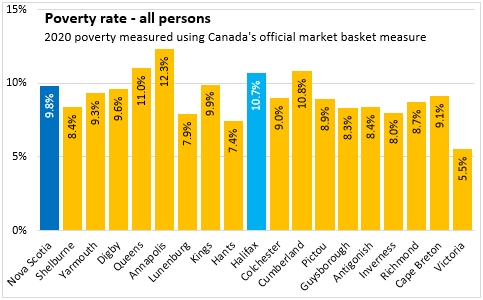
Poverty is highly influenced by family structure. Poverty rates among couples - either with or without children - were generally much lower than overall poverty rates. Nova Scotia's poverty rate among couple families with no children was 3.9% - the same as the national average.
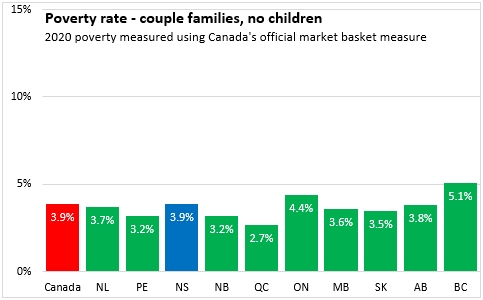
Poverty in Halifax for couples with no children was 3.8%, just below the provincial and national averages. Poverty among couple families without children was lowest in Antigonish County and highest in Annapolis County.
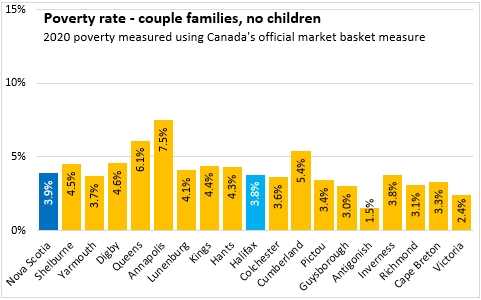
Among couple families with children, Nova Scotia's poverty rate was 4.7%, which was above the national average (4.0%). Prince Edward Island reported the highest poverty among couple families with children while Quebec reported the lowest poverty rate for this family structure.
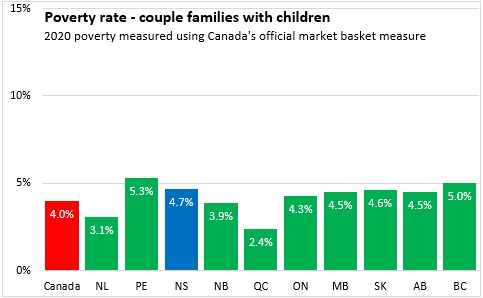
Poverty rates for couples with children were lowest in Shelburne, Lunenburg and Cape Breton Counties and highest in Annapolis County. Halifax poverty among couple families with children was above the provincial average at 5.5%.
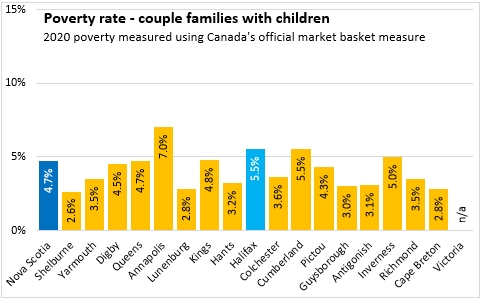
Poverty rates were notably higher for persons in lone parent families at 17.9% in Nova Scotia (14.1% nationally). Newfoundland and Labrador reported the highest poverty rate for lone parents while Quebec reported the lowest.
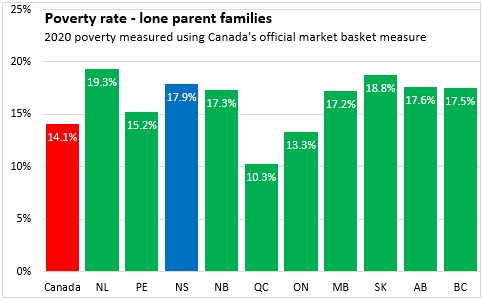
Halifax's poverty rate for lone parents was 18.3% - just above the provincial average. The poverty rate for lone parents was notably higher in Guysborough and Queens Counties and lower in Victoria County.
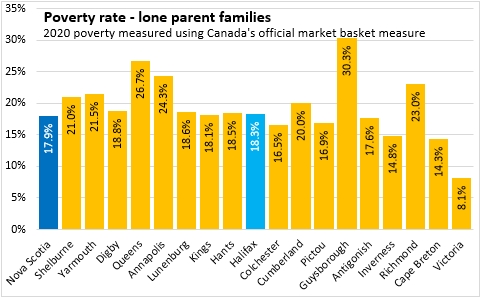
Poverty rates are also notably higher among those who are not part of a census family - particularly those who live with other non-related persons.
Nova Scotia's poverty rate among persons living along was 19.9% - the highest in Canada.
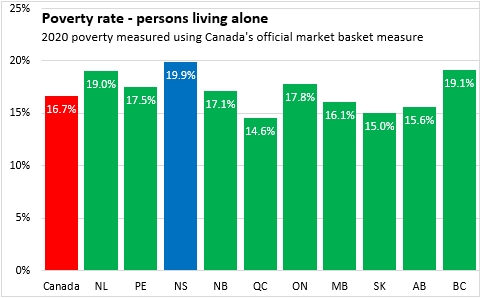
The Halifax poverty rate for persons living along was just above the provincial average at 20.2%. The highest poverty among persons living alone was reported in Annapolis County and the lowest in Inverness County.
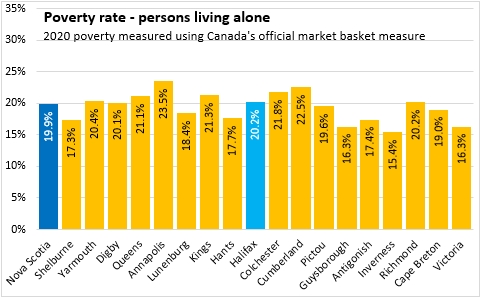
Nova Scotia's poverty rate for persons living with non-relatives was 35.2%, which was just below the national average.
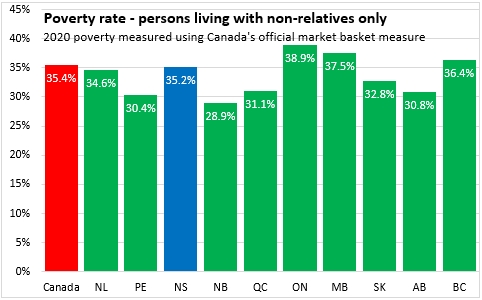
Poverty rates for persons living with non-relatives was notably higher in Antigonish County and lower in Guysborough County. The Halifax poverty rate for persons living with non-relatives was 36.6%.
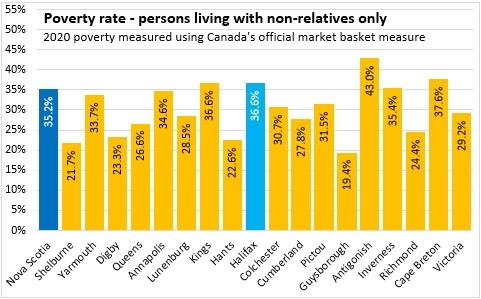
Across all family structures, Nova Scotia's child poverty rate was 11.4% - the highest among all provinces. The national child poverty rate in 2020 was 8.5% with a low of 5.5% in Quebec.

Across counties, the child poverty rates were highest in Annapolis, Queens, Cumberland and Guysborough Counties. The lowest child poverty rate was reported in Victoria County. Halifax's child poverty rate was 11.7%.
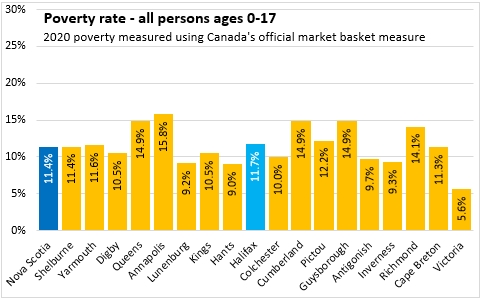
The age cohort with the highest reported poverty rates in Nova Scotia were young adults aged 18-24 at 18.4% (the highest rate in Canada for this age cohort).

Young adults in Halifax reported a notably higher poverty rate of 23.1%, just below the highest young adult poverty rate, which was observed in Antigonish County.
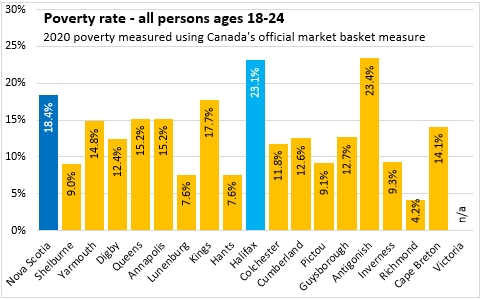
Among those in core working ages (25-54), the poverty rate in Nova Scotia was 9.5% - tied with British Columbia for the highest in Canada.
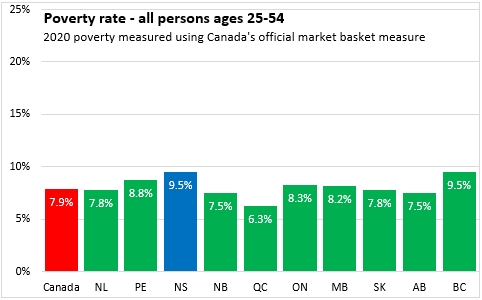
The poverty rate for core working age Haligonians was 9.9%. The highest poverty rates for those of core working age were reported in Annapolis and Cumberland Counties. Victoria County reported the lowest poverty rates for those aged 25-54.
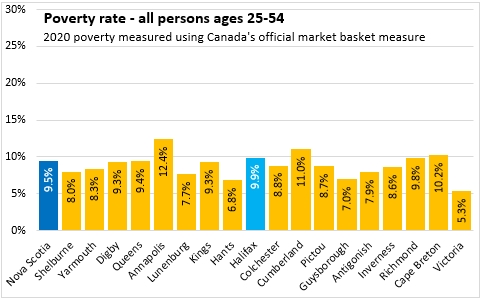
Nova Scotia also reported the highest provincial poverty rate for those aged 55-64: 10.6%.
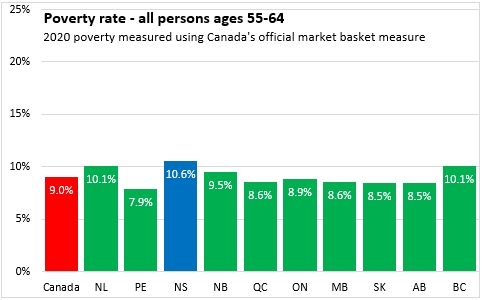
Persons aged 55-64 had higher poverty rates in Queens and Annapolis Counties and lower poverty rates in Victoria and Antigonish Counties. The Halifax poverty rate for those aged 55-64 was 9.4%.
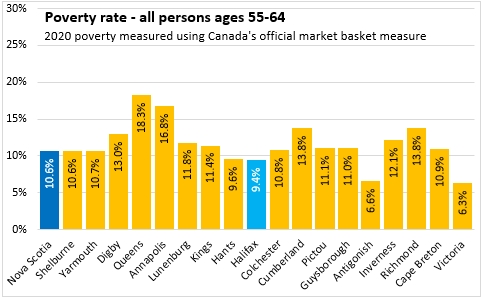
Seniors (aged 65+) generally report lower poverty rates because of Canada's system of income supplements for the elderly. The seniors poverty rate in Nova Scotia was 5.5%; only British Columbia reported a higher seniors poverty rate.
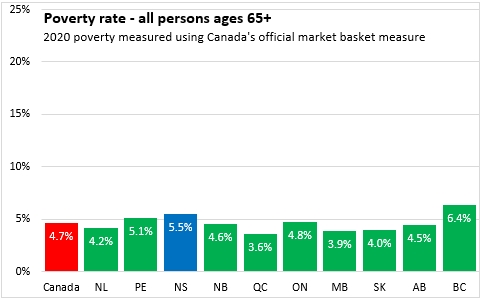
Across counties, seniors poverty rates were highest in Annapolis, Lunenburg and Yarmouth Counties. Richmond County reported the lowest seniors poverty rate. The poverty rate among seniors in Halifax was 5.9%.
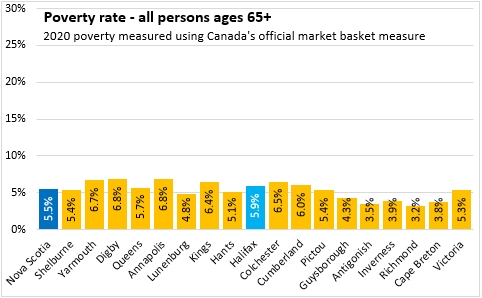
Source: Statistics Canada. Table 98-10-0113-01 Individual Market Basket Measure poverty status by economic family characteristics of persons: Canada, provinces and territories, census divisions and census subdivisions
<--- Return to Archive